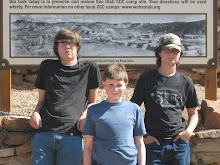Hey, it’s Random Scientist Inc. Sorry I haven't been able to post lately; I've been very busy. So, without further ado, here is Part 1 of my Utahraptor Research. Enjoy!
Introduction:
Dinosaurs have fascinated the minds of humans ever since the word “dinosaur” was invented in 1842. Sir Richard Owen was the person who coined the name, which derives from the Greek words “deinos,” meaning terrible, and “sauros,” meaning lizard. Today, there are over 800 different known species of dinosaur, and there are probably many more different kinds yet to be discovered. The dinosaur we will be discussing is a dromaeosaur. The first dromaeosaur ever found, Dromaeosaurus albertensis, was discovered in Alberta, Canada in 1914. Later, Velociraptor mongoliensis was found in the Gobi Desert in 1922 by Roy Chapman Andrews. A few years later, in 1931, Barnum Brown discovered Deinonychus antirrhopus. Brown first named his find “Daptosaurus,” meaning “active lizard.” Brown made preparations to describe “Daptosaurus,” but he never finished his work. Therefore, the “active lizard” had no name….that is, until John Ostrom officially named it Deinonychus in 1964. But this research isn’t about any of those. It’s about the biggest dromaeosaur ever discovered…so far. In Grand County, Utah, within the Cedar Mountain Formation, James Kirkland and his team of paleontologists discovered a large dromaeosaur previously unknown to science. It had a huge toe claw, long claws on its hands, and an appetite for meat. That’s right…I’m talking about the mighty Utahraptor ostrommaysorum. The “Jack the Ripper” of his day, which was in the early Cretaceous about 125 MYA. Not much is known about the world’s largest dromaeosaur, even though it was discovered a decade and a half ago. I believe I can change that. I have compiled a lot of research on Utahraptor. I have done tons of intense research to give you these facts. Even after you read this, I will continue to dish out new ideas about Utahraptor. Let’s get started!
Physical Appearance:
Utahraptor was, without a doubt, the largest dromaeosaur that ever lived. It was about 2 meters tall, 7 meters long, and weighed half a ton at most. Its skeletal design is like that of a modern turkey or chicken. Its bones were hollow, but strong. It had a rectangular head with a jaw packed with razor-sharp teeth, like steak knives. It had long and relatively thin arms, which ended in three huge claws. The first claw was the shortest, and the middle was the longest. It had a long tail used for balance. It had short and robust legs. Their feet had four toes. The first toe wasn’t used very much. The second toe was a deadly retractable toe claw that could grow up to 12 inches long. The claw was covered with a layer of keratin to protect the bone (keratin is the same stuff your fingernails are made out of). The toe claw was held off the ground so it could stay nice and sharp, ready for combat. The claw was most likely used for stabbing, rather than ripping or tearing apart, its prey. The third and fourth toes were used for balance. Utahraptor and other dromaeosaurs may have had binocular vision, like that of an eagle. Its hearing was probably very excellent. Scientists recently discovered that dromaeosaurs in general could hear low frequency sounds the best. It could smell prey from at least a mile away. Dromaeosaurs like Utahraptor were likely covered in feathers. The arms, legs and tails would’ve been covered in true feathers, whilst the rest of the body was probably covered in protofeathers. However, one small species of dromaeosaur, Microraptor gui, may have been able to glide due to its feathers. The feathers on the arms of young raptors would’ve enabled a special type of locomotion called wing-assisted incline running, or WAIR for short. Discovered by Ken Dial, a Montana zoologist, this is a behavior used by modern birds that combines flapping the wings back and forth, rather than up and down, while running up the sides of trees. This flapping pushes the feet of the birds against the trees, allowing it to run vertically up the trunk. This indicates, but does not prove, that young raptors may have spent part of their lives in trees.
